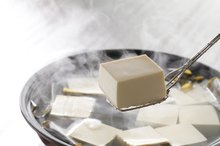What does fact checked mean?
At Healthfully, we strive to deliver objective content that is accurate and up-to-date. Our team periodically reviews articles in order to ensure content quality. The sources cited below consist of evidence from peer-reviewed journals, prominent medical organizations, academic associations, and government data.
The information contained on this site is for informational purposes only, and should not be used as a substitute for the advice of a professional health care provider. Please check with the appropriate physician regarding health questions and concerns. Although we strive to deliver accurate and up-to-date information, no guarantee to that effect is made.
Allergic Reactions to Malic Acid
Malic acid, found primarily in fruits, is extracted to enhance or improve the flavor in many processed and packaged foods and beverages. Consumption can trigger an allergic reaction within a few minutes. If you experience symptoms that lead you to suspect you have an allergy to malic acid, call your doctor.
If you are experiencing serious medical symptoms, seek emergency treatment immediately.
Malic Acid
Commonly added to beverages, cheeses, snack foods, hot dogs, lunch meat and dressings, malic acid can boost savory flavors; create a deeper, richer and natural-tasting flavor; improve aftertaste; and increase the aroma of certain beverages. The presence of malic acid will be disclosed in the ingredients but not in the allergy warning because an allergy to malic acid is not common.
Allergic Reaction
What Products Contain Citric Acid?
Learn More
Malic acid is safe for human consumption and is used widely in many processed foods. If you have an allergy to malic acid, your immune system makes a mistake and identifies the acid as a threatening substance, though it is really safe. All allergic reactions occur when the immune system makes this type of mistake 1. During an allergic reaction the immune system triggers a chain reaction of chemicals that cause common allergy symptoms.
- Malic acid is safe for human consumption and is used widely in many processed foods.
- If you have an allergy to malic acid, your immune system makes a mistake and identifies the acid as a threatening substance, though it is really safe.
Symptoms
Symptoms from a malic acid allergy are the result of the production of immunoglobulin E antibodies, histamine and other chemicals the body releases. These chemicals cause inflammation in your respiratory system, skin, cardiovascular system and digestive system. Common symptoms that develop within minutes of ingesting malic acid are nasal congestion, sinus headaches, sneezing, wheezing, shortness of breath, difficulty breathing, chest tightness, diarrhea, nausea, vomiting, stomach pain, skin rashes, hives and eczema. Call your doctor immediately if you develop any of these symptoms.
- Symptoms from a malic acid allergy are the result of the production of immunoglobulin E antibodies, histamine and other chemicals the body releases.
Warning
Hydrogenated Soybean Oil Allergies
Learn More
Although severe allergic reactions are rare, you need to be aware of common anaphylaxis symptoms that could lead to death 1. Anaphylaxis is a severe allergic reaction that affects your entire body. Call 9-1-1 immediately if you develop facial, lip or tongue swelling, the sensation of a lump in your throat, hives, cannot breathe or feel lightheaded, dizzy or nauseous.
Related Articles
References
- MedlinePlus: Allergic Reactions
- MedlinePlus: Food Allergy
- Taylor MB, Yanaki JS, Draper DO, Shurtz JC, Coglianese M. Successful short-term and long-term treatment of melasma and postinflammatory hyperpigmentation using vitamin C with a full-face iontophoresis mask and a mandelic/malic acid skin care regimen. J Drugs Dermatol. 2013 Jan;12(1):45-50.
- Tyka AK, Chwastowski M, Cison T, et al. Effect of creatine malate supplementation on physical performance, body composition and selected hormone levels in spinters and long-distance runners. Acta Physiol Hung. 2015 Mar;102(1):114-22. doi:10.1556/APhysiol.102.2015.1.12
- Rodgers AL, Webber D, de Charmoy R, Jackson GE, Ravenscroft N. Malic acid supplementation increases urinary citrate excretion and urinary pH: implications for the potential treatment of calcium oxalate stone disease. J Endourol. 2014 Feb;28(2):229-36. doi:10.1089/end.2013.0477
- Manfredini R, De giorgi A, Storari A, Fabbian F. Pears and renal stones: possible weapon for prevention? A comprehensive narrative review. Eur Rev Med Pharmacol Sci. 2016;20(3):414-25.
- Russell IJ, Michalek JE, Flechas JD, Abraham GE. Treatment of fibromyalgia syndrome with Super Malic: a randomized, double blind, placebo controlled, crossover pilot study. J Rheumatol. 1995;22(5):953-8.
- Gómez-Moreno G, Aguilar-Salvatierra A, Guardia J, et al. The efficacy of a topical sialogogue spray containing 1% malic acid in patients with antidepressant-induced dry mouth: a double-blind, randomized clinical trial. Depress Anxiety. 2013 Feb;30(2):137-42. doi:10.1002/da.22017
- Tang SC, Yang JH. Dual Effects of Alpha-Hydroxy Acids on the Skin. Molecules. 2018;23(4). doi:10.3390/molecules23040863
Writer Bio
Diane Marks started her writing career in 2010 and has been in health care administration for more than 30 years. She holds a registered nurse license from Citizens General Hospital School of Nursing, a Bachelor of Arts in health care education from California University of Pennsylvania and a Master of Science in health administration from the University of Pittsburgh.









